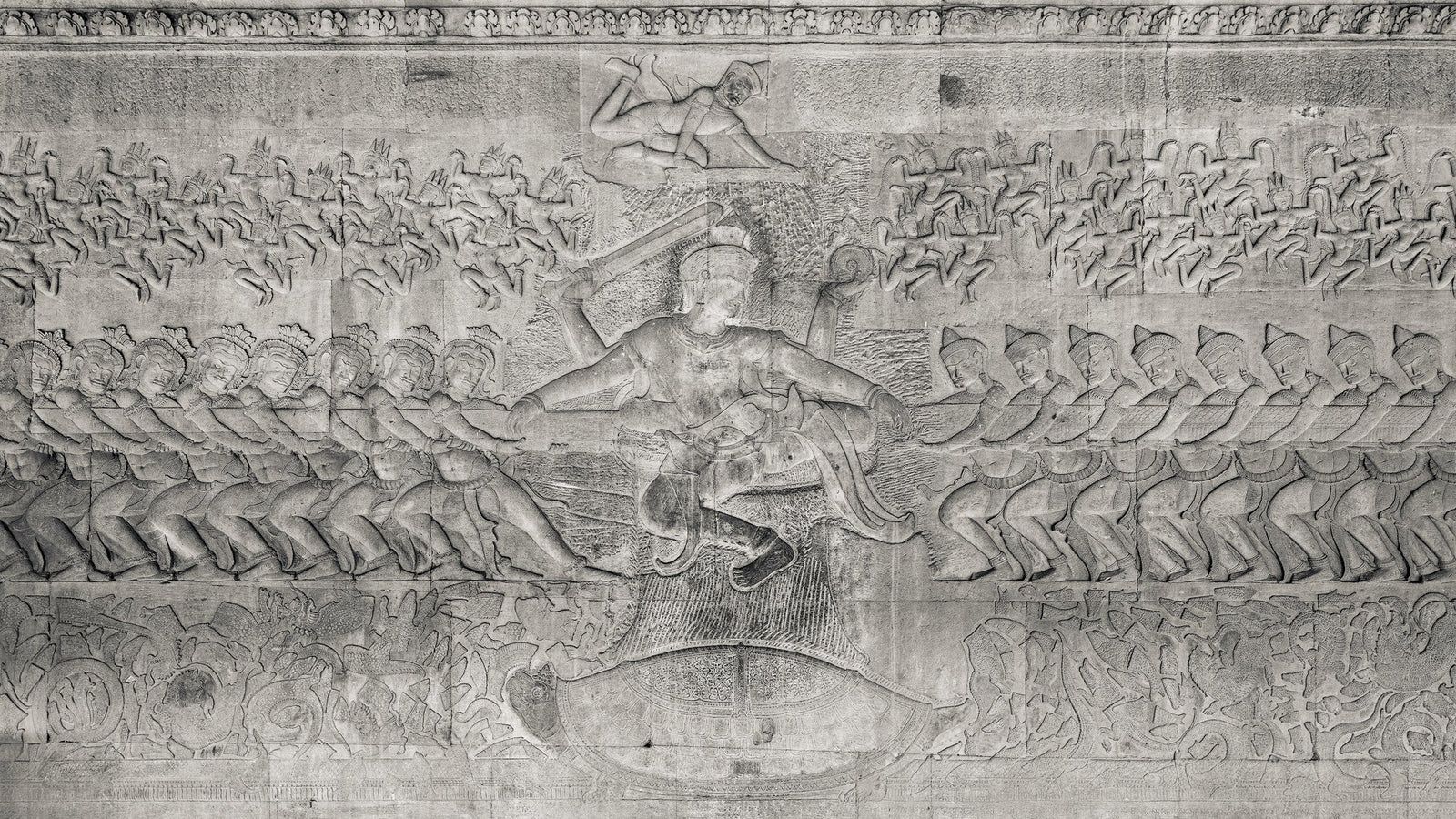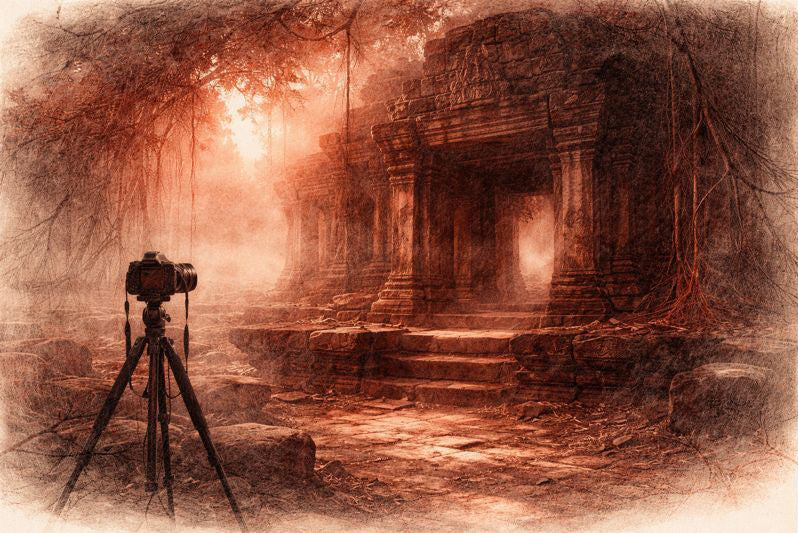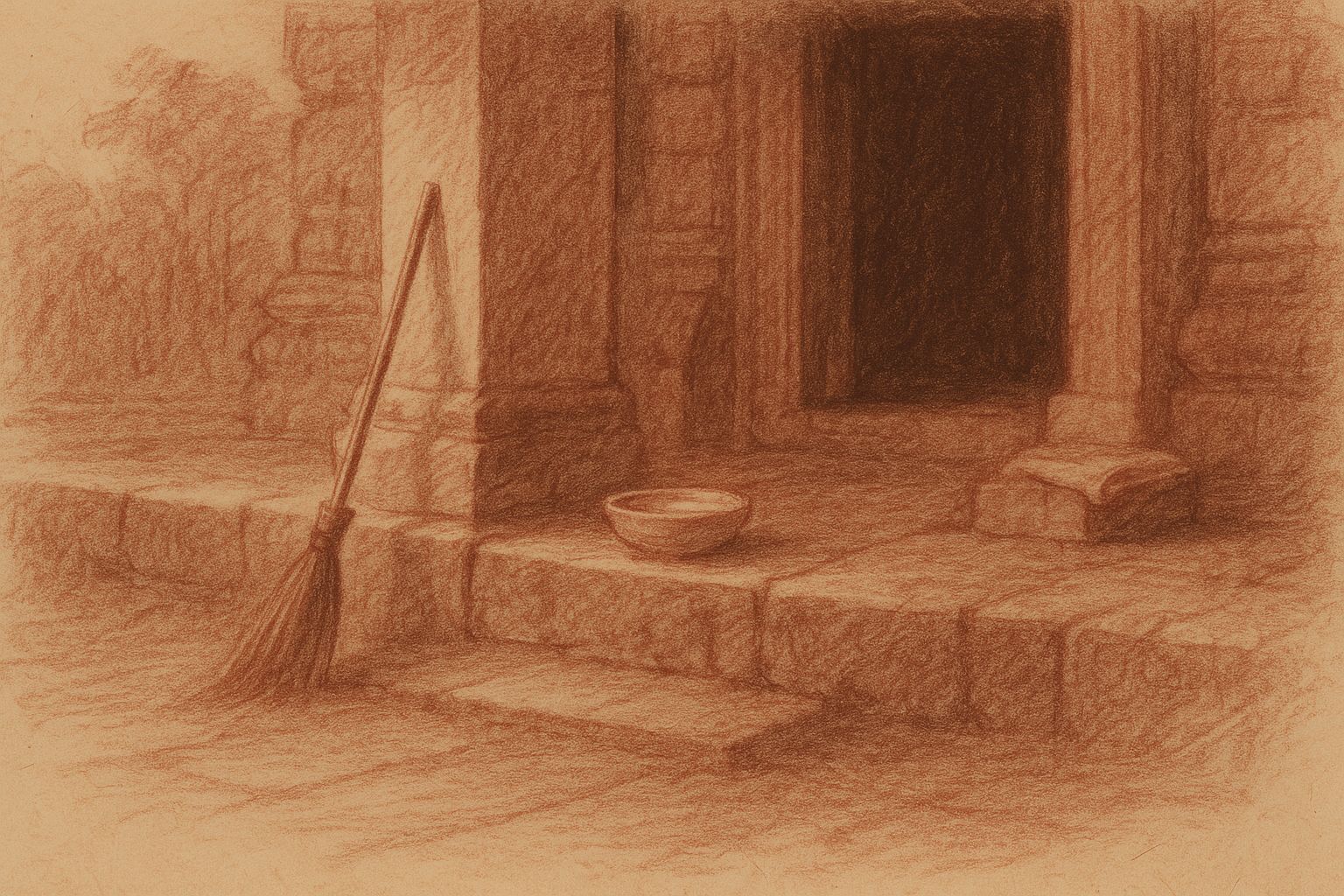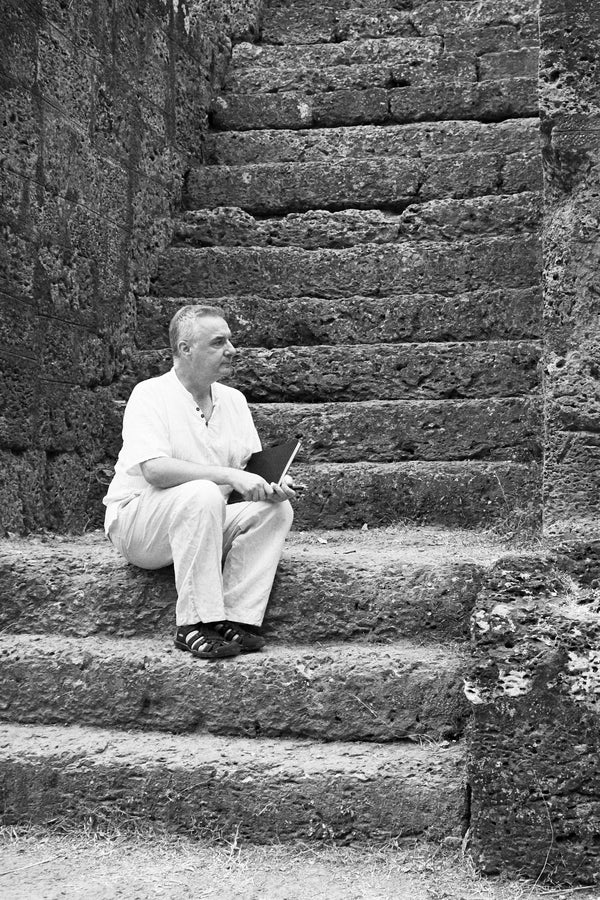Complimentary worldwide shipping on orders over $400 · No import tariffs for most countries
Complimentary worldwide shipping on orders over $400 · No import tariffs for most countries

The Churning of the Ocean of Milk at Angkor Wat Temple, Part I: The Myth
7 min read
This morning Annie and I visited the majestic Angkor Wat Temple, and for the thousandth time we were awed by the beauty and artistry of the Churning of the Ocean of Milk relief gallery. In a temple famous for its fabulous carvings, worked in stone some nine hundred years ago, this spectacular relief, extending 48.45 metres along the 3rd enclosure in the southern wing of the eastern gallery, is the most famous. Its abstract clearness has no parallels in contemporaneous Indian, Middle Eastern or European reliefs.
The Myth
Mother Earth was once overburdened by the tyranny of the Daitya demons and evil giants fighting the gods and interfering with sacrifices. She sought refuge with Brahma who, accompanied by Shiva and other gods, went to intercede with the Supreme Lord who manifested himself as Vishnu. We will discuss this part of the tale later in The Invitation for Vishnu to Descend.
The active involvement of Vishnu in restoring order on Earth is best exemplified by his participation in the Churning of the Ocean of Milk.
To bring back peace and order, it was first necessary to restore the dharma that had been corrupted by the asuras and evil beings. It was essential for the gods to regain the elixir of immortality, the amrita. To obtain this they took the great naga Vasuki as a rope, twisted it around Mount Mandara as the pivot and started churning the Ocean of Milk, in collaboration with various classes of asuras.
Eventually, after realising that thousands of years of work were unsuccessful, they sought the help of Vishnu. His advice was to work together and organise themselves. At this point, Mount Mandara suddenly started to sink and Vishnu, in his incarnation as the tortoise Kurma, had to support the mountain on the back of his shell, while Indra ‘squeezed down the top of the mountain with his foot’ to stabilise it.

Figure 1. Vishnu Directing the Churning of the Ocean of Milk, Angkor Wat Temple, Cambodia
You can see a larger version of this image by clicking here. ⧉
The spinning of Mount Mandara created such a violent whirlpool that the mythological creatures and fish around it were torn to pieces in great numbers. The Ocean of Milk was churned for another thousand years before producing the much-desired elixir, the amrita. The other products were: the apsaras; Dhanwantari, the physician to the gods and bearer of the amrita jar; Lakshmi, the goddess of fortune and beauty; Varuni, the goddess of wine (sura); Chandra, the moon; Rambha, a lovely nymph; Uchchaihshravas, the flying horse; Kaustubha, the celebrated jewel; Parijata, the celestial tree; Surabhi, the cow of plenty; Airavata, the white elephant; Shanka, the conch of victory; Dhanus, the famous bow; and Visha, the poison.
According to the Vishnu Purana, the Daityas came to be known as asuras because after the Churning they rejected Varuni, the goddess of sura "wine", while the devas accepted her and came to be known as suras.
The Texts
The textual sources for the Churning of the Ocean of Milk myth are the Mahabharata (I, chapters 15-17), the Ramayana (Book I, chapter 45) and the Bhagavata Parana (Book VIII, chapter 7). These texts differ in the description of the products of the churning, the order in which they appear, and the people attending the event. I believe it is that the Puranic version, summarised below, that most closely relates to this sculptural representation.
At the beginning of the world, the gods (devas) and demons (asuras) were engaged in a thousand year battle to secure amrita, an elixir that would render them immortal and incorruptible. After some time, when they became tired and still had not achieved their goal, they asked the help of Vishnu. He appeared and ordered them to work together, not against each other. Working together, they then commenced the churning of the Ocean of Milk by using Mount Mandara as the pivot and the five-headed naga Vasuki as the rope. However, the mountain suddenly began to sink. Vishnu incarnated as the tortoise Kurma to support the pivoting mountain on his back. Many gods also assisted, including Indra, by keeping the pivot in position. The spinning of Mount Mandara created such a violent whirlpool that the creatures and fish around it were torn to pieces. The Ocean of Milk was churned for another thousand years before producing the much-desired elixir and other treasures, amongst which are the goddess Lakshmi (Sri Devi), the elephant Airavata, the horse Uchchaihshravas, a wishing tree (Parijata) and the apsaras. The naga Vasuki vomited floods of black venom due to his mishandling by the devas and asuras during the churning. This would have been enough to poison everybody had it not been for Shiva, who drank it all; as a result, his mouth remaining stained forever with a black line.
A bitter fight then broke out between the devas and the asuras for possession of the amrita. Vishnu intervenes again, this time as the beautiful girl Mohini, and regains possession of the amrita which he keeps safe from harmful use. We will examine this part of the myth, as represented at Angkor, at a later date. Once peace is established, Indra is reinstalled as the king of the gods.
Summarised from the Bhagavata Parana (Book VIII, chapter 7)
According to the Mahabharata, Vishnu did not take an active part in the churning, limiting his participation to advising and encouraging the devas. In the Bhagavata Parana and the Ramayana narratives, however, Vishnu was everywhere. He appears in the form of the tortoise Kurma to support the rotating Mount Mandara, and also as the stabiliser of the mountain 'by placing one hand over it'. He appears simultaneously pulling the snake amongst the devas and amongst the asuras. He participates also in a gigantic form invisible to all. It is Vishnu that infuses Vasuki with strength and, in his original form, invigorates the devas with power.
The Ramayana has a peculiarly significant influence on this representation of the Churning, as we will see later.
As we read from the Bhagavata Parana above, Vishnu appears in this tale again later, after the churning was completed, assuming the body of a charming woman (Mohini) to regain the amrita stolen by the Daityas. But Vishnu’s involvement does not end here: once more he had to join battle in the final defeat of the asuras, which we will examine in another large relief panel of the 3rd enclosure at Angkor Wat, The Battle between the Devas and the Asuras.
Alternative Readings
In this depiction of the Churning, the 92 asuras have a numerical advantage over the 88 devas, and the general pulling movement seems to be in favour of the asuras. This imbalance between the two factions seems to indicate that the asuras are on the verge of gaining possession of the amrita, threatening to worsen the universal crisis already in place. This requires a new restoration of the order, and the sacrificial incarnation of a god, in a continuous process of creation. Thus the reading of the relief in the context of a sacrificial process is introduced. The panel’s three registers are equivalent to three visual layers, of which the lower, filled with animals and vegetal elements, would function as the substitute of the victim. The main, middle register, with the Churning, has Vishnu at its centre as the officiant, sacrificer and sacrificed (he had to incarnate on earth). Vasuki is the evident sacrificial victim. The highest register depicts the newly created apsaras rejoicing in an ideal new order. Mount Mandara, the cosmic mountain, is the sacrificial post, uniting the three worlds. Kurma, who has provided stability to the process of creation, is placed at the base of the sacrificial site, as in Hindu altars.
Several authors have pointed out the parallels between the myth of the Churning of the Ocean of Milk and that of the 'Birth of Brahma' from Vishnu’s umbilicus while he rests on Ananta. In the Churning, Vishnu as Kurma supporting Mount Mandara corresponds to Vishnu reclining on Ananta in the Cosmic Ocean sustaining Brahma on the lotus. Mount Mandara as the churning pole can he correlated with the lotus stem arising from Vishnu’s navel to support Brahma. Since both Mandara/Meru and the lotus are symbolic of the centre of the Universe, in both cases we are dealing with the quintessence of the myth of Creation.
There is also an analogy between Shiva and Mount Mandara/Meru. Shiva was venerated mainly in the form of a linga, the erect phallus. Both mountain and linga act as the focal element in the myth of creation. The linga developed from the Hindu idealisation of the cosmic axis of the ancient Indian cosmology. In such a primordial event as the Churning of the Ocean of Milk, the axis became the churning pole, in turn equated with Mount Mandara/Meru and the axis of the world. At the base of the pole, the amrita is collected into a vase (kalasha), thus there is the sexual symbolism of the pole in the vase and its analogy with that of the linga entering the yoni.
It has been suggested that the Churning of the Ocean of Milk was symbolically enacted by the Khmer as a tug-of-war exploit during special ceremonies such as the coronation of a king, symbolic of the reinstallation of Indra as Lord of the Heavens and King of the Gods. After losing his status, Indra participated in the Churning as a penance, and was re-instated after the battle for the possession of the amrita.
Next, we will read the full relief, section by section, and attempt to identify each of the characters represented here and discuss the roles they play in this tale, starting with The Churning of the Ocean of Milk at Angkor Wat Temple, Part II: The Asuras.
Also in Library

Before the Shutter Falls
3 min read
Before the shutter falls, fear sharpens and doubt measures the cost of waiting. In the quiet hours before dawn, the act of not-yet-beginning becomes a discipline of attention. This essay reflects on patience, restraint, and the quiet mercy that arrives when outcome loosens its hold.

Those Who Keep the Way Open — On the Quiet Guardians of Angkor’s Thresholds
3 min read
Quiet gestures shape the way into Angkor — a swept stone, a refilled bowl, a hand steadying a guardian lion. This essay reflects on the unseen custodians whose daily care keeps the thresholds open, revealing how sacredness endures not through stone alone, but through those who tend its meaning.

Multiplicity and Mercy — The Face Towers of Jayavarman VII
5 min read
A new vision of kingship rises at the Bayon: serene faces turned to every horizon, shaping a world where authority is expressed as care. Moving through the terraces, one enters a field of steady, compassionate presence — a landscape where stone, light, and time teach through quiet attention.
Join My Studio Journal
Receive occasional letters from my studio in Siem Reap—offering a glimpse into my creative process, early access to new fine art prints, field notes from the temples of Angkor, exhibition announcements, and reflections on beauty, impermanence, and the spirit of place.
No noise. No clutter. Just quiet inspiration, delivered gently.
Subscribe and stay connected to the unfolding story.

Join My Studio Journal
Receive occasional letters from my studio in Siem Reap—offering a glimpse into my creative process, early access to new fine art prints, field notes from the temples of Angkor, exhibition announcements, and reflections on beauty, impermanence, and the spirit of place.
No noise. No clutter. Just quiet inspiration, delivered gently.
Subscribe and stay connected to the unfolding story.
